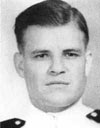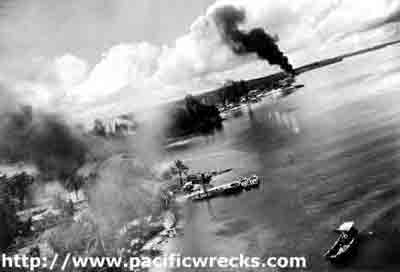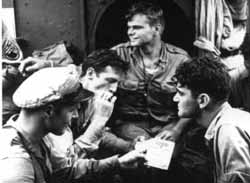Nathan G. Gordon
U.S. Navy PBY Catalina pilot and Medal of Honor Recipent
In memory: Nathan Gordon passed away on September 9, 2008
Lt. (jg) Nathan Gordon
made four stall landings in his Black Cat PBY in rough waters
of Kavieng harbor to collect ditched
survivors
of the strike. Coming under intense enemy fire, he and his
crew located and picked up 15 Army fliers shot down during the
attack.
His actions on this day earned him the Medal of Honor. In
2003 Nate Gordon was interviewed by Pacific Wrecks.
Enlistment
 I was born September 4, 1916 in Morrilton, Arkansas. I enlisted in May
1941 and was in Jacksonville, Florida training until February 1942. Of
course I remember December 7, 1941, it was a Sunday, and we had the day
off. I was in Jacksonville watching a picture, when they cut into and
said on a microphone "All
Navy personal report to your base". Things started happening
quickly of course Next, we went up to Norfolk, Virginia where we got
our PBY planes and that is where I joined VP-34. We continued our training
also. I was born September 4, 1916 in Morrilton, Arkansas. I enlisted in May
1941 and was in Jacksonville, Florida training until February 1942. Of
course I remember December 7, 1941, it was a Sunday, and we had the day
off. I was in Jacksonville watching a picture, when they cut into and
said on a microphone "All
Navy personal report to your base". Things started happening
quickly of course Next, we went up to Norfolk, Virginia where we got
our PBY planes and that is where I joined VP-34. We continued our training
also.
Caribbean Convoy Protection
Next, we were sent down to the Caribbean. As you
know, there were U-boats operating down there to protect the convoys
by searching for submarines in day and mostly night missions. Our main
base, where my crew was, was at Guantanamo Bay, Cuba, but we also had
planes at Kingston, Jamaica, and Trujillo, Honduras. We never saw any
U-boats, and no shipping was lost while we were down there, so maybe
our efforts help to deter them somewhat.
Hawaii
On June 7, 1943 our squadron was relieved of duties
in the Caribbean and relocated to San Diego, were we got new planes,
PBY-5's and flew them out to Kaneohe, Hawaii. From there, VP-34 was
again split up. Three were sent on a big hush-hush mission. Later,
we found out that those three planes were to follow Mrs. Eleanor Roosevelt
on her flight to Australia in case they had problems and needed rescue
or to be picked up. Six planes, including mine were sent to Midway.
Five to Canton Island, and one at Johnston Island.
Midway
I was at Midway from June to July 1943 for six weeks
flying daylight patrols to search for Japanese ships. Of course,
we never found any. It was a difficult mission because we had to maintain
total radio silence.
Funafuti
After Midway, we went down to Funafuti in August
1943 with six PBY's to fly patrols there. Before the invasion of Tarawa,
were were to fly over the area in the three days prior to the invasion.
I was assigned to fly on the 2nd night before the invasion. They had
told me that the attack was not happening until the next morning, but
when airborne we spotted a huge armada of ships. We could not tell
if they were theirs or ours, but luckily we had on our IFF [International
Friend or Foe] and did not have any problems. When we landed we learned
that it was the invasion force!
Australia
Next, we went flew to Brisbane, and from there to Adelaide,
and then across the continent to Perth in Western Australia arriving
on September 29, 1943. We had a seaplane base just to the north of
the city. We flew searches out of Perth and also did more training,
before leaving in December 1943.
Anti-Shipping Strikes
For the next six months, we flew anti-shipping strikes
against Japanese shipping to Rabaul in the Bismarck sea and along the
coast. We were so slow, we had to fly at night. We would attack at
mast-top height and drop 500lbs or 1,000lbs bombs. We would not fire
our machine guns, so as not to give away our position.
VP-34 "Black Cats" Based at Samarai
Samarai
Island located at the far eastern tip of
New Guinea, near Milne Bay. By January 6, 1944 we were flying our first
missions in New Guinea.
We were called the " Black Cats". The nickname came from
the flat black paint applied to the Catalinas and the nighttime
strike missions
we flew. Our insignia was a cat’s face with its jaws champing
down on an enemy cargo vessel. On top of the cat’s head was
a set of radio headphones and a ball cap. Across the top of the
insignia was
the legend Black Cats, and at the bottom VP-34, and Southwest Pacific.
Most of my missions were flown in PBY "Arkansas
Traveler" 08139.
Rescue Mission to Kavieng February 15, 1944
Of course, we had no idea what was about to happen
on that day at the time. We got a call that an A-20 had ditched
and to go to Kavieng for
a rescue.
At the time, we were about 100 miles from Kavieng at Vitu Island off New Britain which was our rendezvous point
for the mission. We had four P-47's with us as escorts. (348th FG from Finschafen).
All our rescues were in Kavieng Harbor. Kavieng had
a closed in harbor, but no breakers or protection from the rougher
seas. That day, there were large swells in the water too. Later
they would tell us fifteen to eighteen feet high.
First Landing
We went to the location we had been given, and
could see die marker, some wreckage and a raft. We could not
see if anyone was down there though, so we put down in the water
to find out for sure. Any open sea landing has a lot of dangers.
As I said, there were large swells in the water this day. I tried
to align the plane with the swells so we could land with them
in the same direction.
We dropped a smoke bomb at one end, and another
down at the far end of where I wanted to land to judge the wind.
We were going to land in between the swells. I made a good landing
by power stalling the plane. This meant bring it in really slow
and cutting the power so the plane drops out of the sky straight
down to land in the shortest distance. When the plane hit the
water, the crew reported that some rivets had popped out of the
bottom pontoon!
I pulled the plane up so that the guys in the
fuselage could investigate. There was no sign of the crew, they
must have been dead or drowned. We found some debris - oil, dye
marker two life jackets and a half inflated raft.
A-20G Havoc 42-86616
(3rd BG, 13th BS ) pilot 1st Lt. William T. Pearson gunner MSgt Donald N. Gamage crashed 35 miles south-southwest of Kavieng
Second Landing
After taking, off, we got a call from a B-25 that
was spotting from the air and was radioing us instructions and coordinates
of ditched planes. He called in the position of a B-25 that had ditched.
The aircraft spotting from the air was B-25 Mitchell piloted by
Major Chester A. Coltharp, C. O. 498th Bombardment Squadron.
I made another stall landing to pick up this crew.
All six were in the water. When we landed, we realized that we would
have to cut the one engine when we picked up the crew. The swells were
so high, they were right up to the engines which as you know are on
the top edge of the wing of the PBY. We were afraid that they might
hit the prop when we got close to them. I turned to Wily, our mechanic
and asked him if we shut off the port engine, would we be able to restart
it? He said yes, so I did.
B-25D "Gremlins
Holiday" 41-30041
(345th BG, 498th BS) pilot 1st Lt. Edgar R. Cavin ditched four miles northwest of Kavieng roughly 400 yards offshore.
Gunfire from shore was hitting around us. Machine
guns, small arms and some larger shells. Luckily, none hit us, and
I think the swells helped us here, as the plane would have disappeared
behind a swell to anyone trying to shoot at us from the shore. We pulled
right up to them, and Kelly at waist position threw out a rope and
Joe Germean pulled them inside. Joe was was the strongest guy in our
crew, and pulled in all of the B-25 crew.
We restarted the port engine without a problem,
and took off once again, and started for home. I would say we got
twenty miles out, when the same guy called again. "We got another crew
for you to pick up". Two of the P-47's had left, because they
were low on fuel.
Third Landing
Our radio went off again, and we got the call from
the spotting B-25 to rescue another crew. This plane had ditched about
a mile from shore. Again, we power stalled to land, and had to cut the
left engine so as not to hit the crew in the water. This time it was
another B-25 crew. Only three were there. Our remaining two P-47 escorts
left while we were making the landing because they too were low on fuel.
B-25D "Pissonit" 41-30370
(38th BG, 71st BS) pilot 1st Lt Eugene E. Benson ditched 2 1/2 miles off North Cape near Kavieng
We now had ten aboard, and we started for home.
I would say we got about 20 miles away from Kavieng when again, our
radio went off. It was the same B-25 called in and told us about
another crew, this time very close to the shore. Since our escort
had left, I asked him "Are you going to stay with me?" and he replied
back "Yes". We had been told that the Japanese had float
planes there too, and I was afraid about meeting one of them now
that we were alone.
Fourth Landing
 We would have to land closer to shore this time.
I did not consult with the crew, there was no time for making decisions,
I just did it, and nobody complained. That is what had to be done,
there was no time to discuss things. We made our final landing, only
600 yards from shore. We had to make our approach over the town,
where later I was told some of the heavies AA fire was coming from.
There was a lot of fire coming at us from the shore. Small arms and
machine guns as well as larger stuff. Again, none hit us. The swells
helped us here, as the plane would disappear to anyone trying to
shoot at us from the shore when we were behind a crest. We did the
same thing, and took the five of them in through the waist hatch. The
pilot was Captain William Cavoli, who was from Newport, Arkansas and
later would become a friend. We would have to land closer to shore this time.
I did not consult with the crew, there was no time for making decisions,
I just did it, and nobody complained. That is what had to be done,
there was no time to discuss things. We made our final landing, only
600 yards from shore. We had to make our approach over the town,
where later I was told some of the heavies AA fire was coming from.
There was a lot of fire coming at us from the shore. Small arms and
machine guns as well as larger stuff. Again, none hit us. The swells
helped us here, as the plane would disappear to anyone trying to
shoot at us from the shore when we were behind a crest. We did the
same thing, and took the five of them in through the waist hatch. The
pilot was Captain William Cavoli, who was from Newport, Arkansas and
later would become a friend.
B-25D
Mitchell 41-30531
(345th BG, 500th BS) pilot Captain William J. Cavoli ditch into Kavieng Harbor about three quarters of a mile from shore.
 Head for Home Head for Home
We had a total of fifteen people aboard that we had
rescued. Some were hurt bad, and the crew got to work helping them
as best we could. We flew to Finchafen, and dropped them all off. There
he unloaded everyone we had rescued. The really wounded ones immediately
went to the hospital ship there (San Pablo AVP 30). That was the last
time I saw any of them. We simply refueling and returning to Samarai.
Total flying time was 7.4 hours to Finchafen and another 2.6 hours more
back to our base at Samari.
Medal of Honor
I had no idea that I had been
recommended for the award of course. After the Kavieng mission, we
were still flying daily missions, until September 1944. Later, the
whole crew was flown to Brisbane, where the Vice-Admiral presented
the entire crew with the Silver Star, and me with the Congressional
Medal of honor. Admiral William F. Halsey mentioned the rescue in a telegram after the mission: "Please pass my admiration on to that saga writing Kavieng Cat
crew - Halsey". The Medal of Honor is displayed at the MacArthur
Museum of Arkansas Military History.
Medal of Honor Citation
 "For
extraordinary heroism above and beyond the call of duty as commander of a Catalina
patrol plane in rescuing personnel of the U.S.
Army 5th Air Force shot down in combat over Kavieng Harbor in the Bismarck
Sea, 15 February 1944. On air alert in the vicinity of Vitu Islands, Lt.
(then Lt. j.g.) Gordon unhesitatingly responded to a report of the crash
and flew boldly into the harbor, defying close-range fire from enemy shore
guns to make 3 separate landings in full view of the Japanese and pick up
9 men, several of them injured. With his cumbersome flying boat dangerously
overloaded, he made a brilliant takeoff despite heavy swells and almost total
absence of wind and set a course for base, only to receive the report of
another group stranded in a rubber life raft 600 yards from the enemy shore.
Promptly turning back, he again risked his life to set his plane down under
direct fire of the heaviest defenses of Kavieng and take aboard 6 more survivors,
coolly making his fourth dexterous takeoff with 15 rescued officers and men.
By his exceptional daring, personal valor, and incomparable airmanship under
most perilous conditions, Lt. Gordon prevented certain death or capture of
our airmen by the Japanese." "For
extraordinary heroism above and beyond the call of duty as commander of a Catalina
patrol plane in rescuing personnel of the U.S.
Army 5th Air Force shot down in combat over Kavieng Harbor in the Bismarck
Sea, 15 February 1944. On air alert in the vicinity of Vitu Islands, Lt.
(then Lt. j.g.) Gordon unhesitatingly responded to a report of the crash
and flew boldly into the harbor, defying close-range fire from enemy shore
guns to make 3 separate landings in full view of the Japanese and pick up
9 men, several of them injured. With his cumbersome flying boat dangerously
overloaded, he made a brilliant takeoff despite heavy swells and almost total
absence of wind and set a course for base, only to receive the report of
another group stranded in a rubber life raft 600 yards from the enemy shore.
Promptly turning back, he again risked his life to set his plane down under
direct fire of the heaviest defenses of Kavieng and take aboard 6 more survivors,
coolly making his fourth dexterous takeoff with 15 rescued officers and men.
By his exceptional daring, personal valor, and incomparable airmanship under
most perilous conditions, Lt. Gordon prevented certain death or capture of
our airmen by the Japanese." |
 Return Home Return Home
After New Guinea, I was sent back to the United States to become an instructor
at Jacksonville, Florida. After that, I was flying at Washington DC
until the war ended. I stayed friends with William Cavoli after the war,
he recently invited me over to visit. I sometime go
to the Medal of Honor reunions too.
Memorials
Nathan G. Gordon passed away September 9, 2008 at Arkansas Medical Services Center in Little Rock, AR. He is buried at Elmwood Cemetery in Morrilton, AR.
References
Austin American Statesman “Twin Engined Angels Save 38 Lost Airmen in 35 Days” by Sgt Gordon D . Marston (Marine Corps Correspondent) February 21, 1944
"News dispatches from the Southwest Pacific Feb. 16 told of the daring rescue of 15 allied airmen by a Navy Catalina [PBY "Arkansas Traveler" 08139 piloted by Nate Gordon] flying boat when eight allied planes were shot down at Kavieng."
Reno Gazette Journal "Navy Aviator Wins Top Medal: Rescue of 15 Brings Award" July 31, 1944
"The Congressional medal of honor was presented today to Lt. Nathan G. Gordon of Morrilton, Ark., navy pilot who landed his Catalina flying boat in Kavieng harbor last Feb. 15 and rescued 15 downed American airmen under the guns of the Japanese. It was the first navy presentation of America's highest military award in the southwest pacific. Vice Adm. Thomas C. Kincaid, commander of the seventh fleet, made the award."
Interview with Nathan Gordon by Justin Taylan 2003
FindAGrave - Nathan Green Gordon (photos, grave photo)
Thanks to Nate Gordon for additional information
|